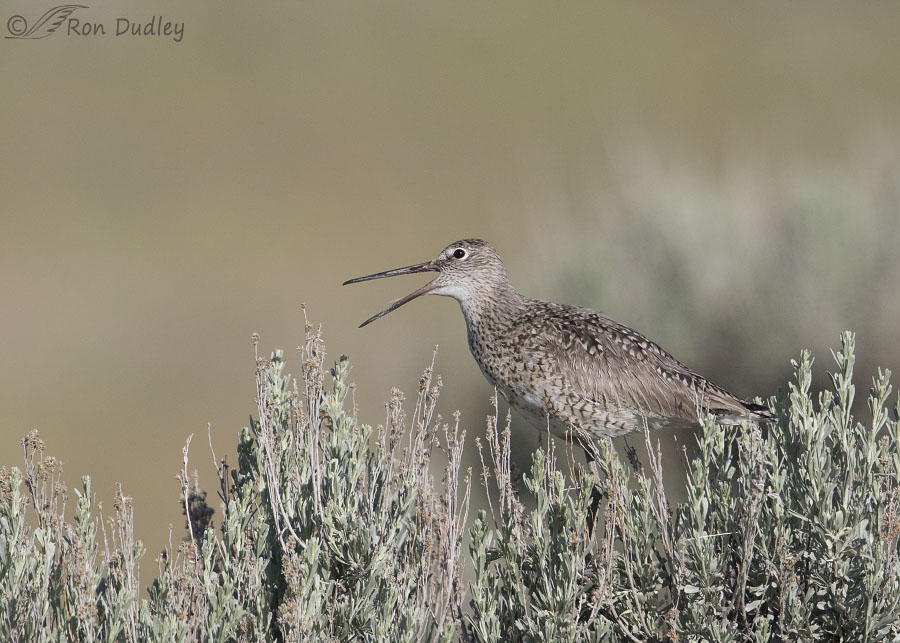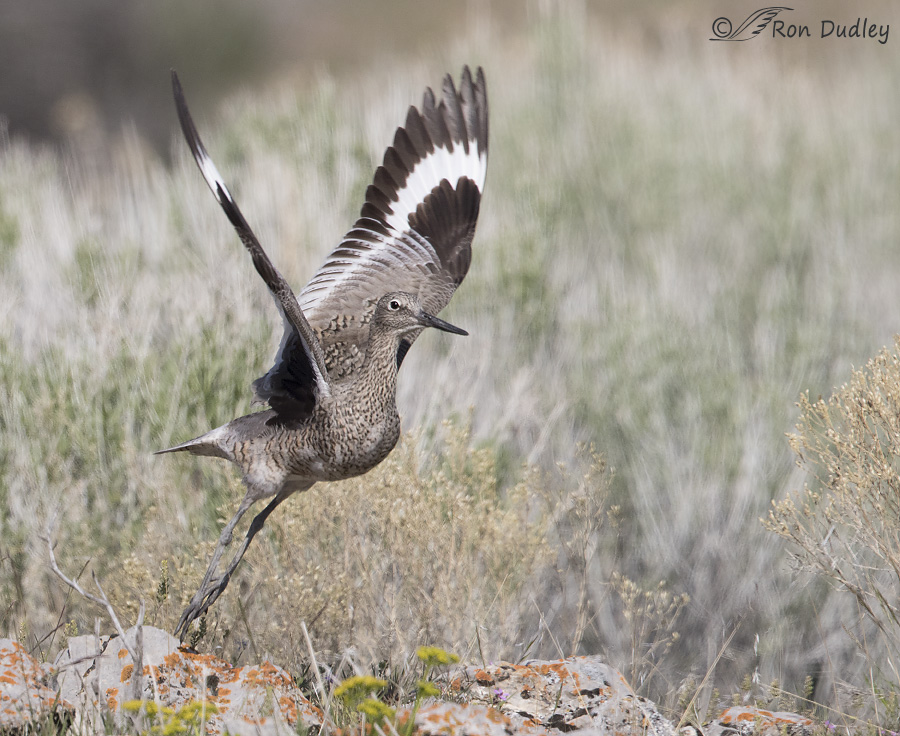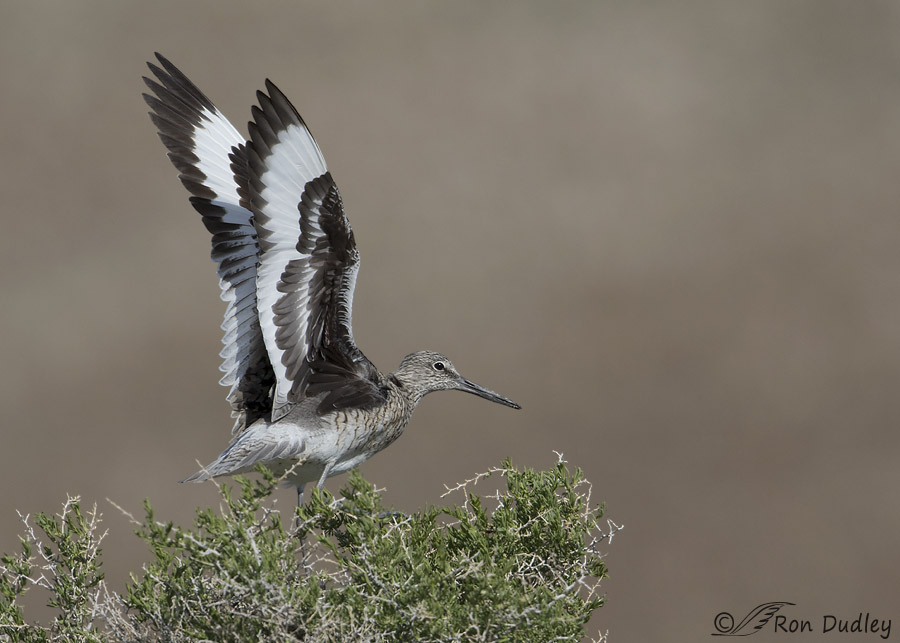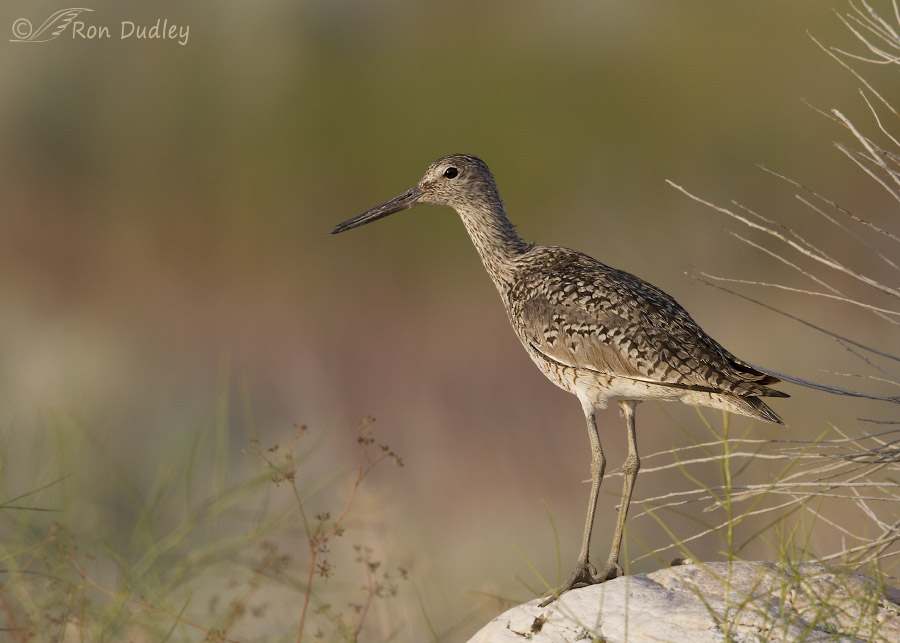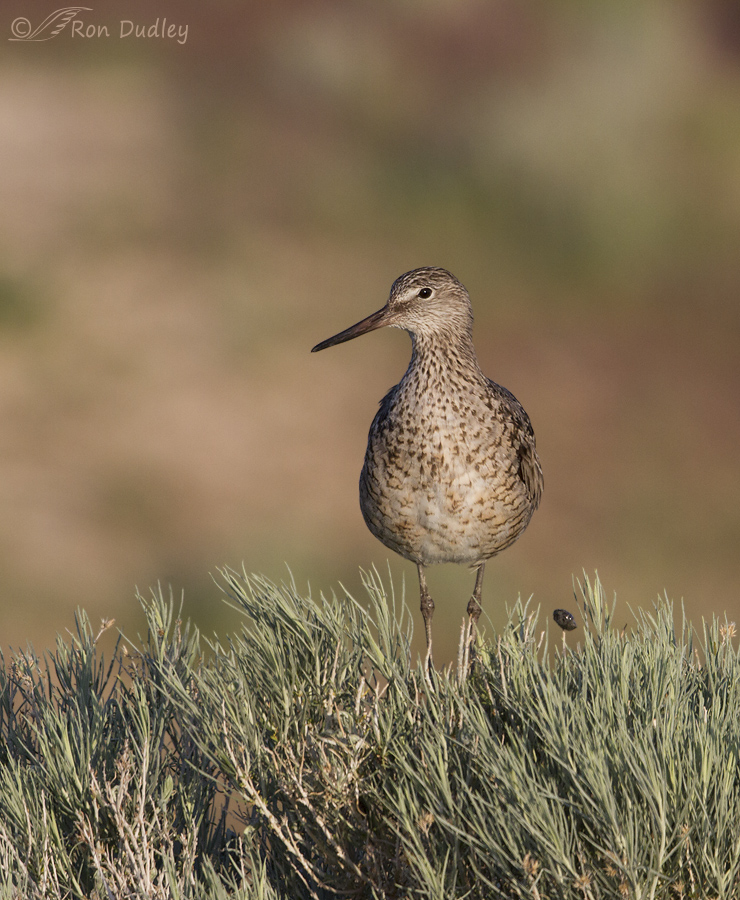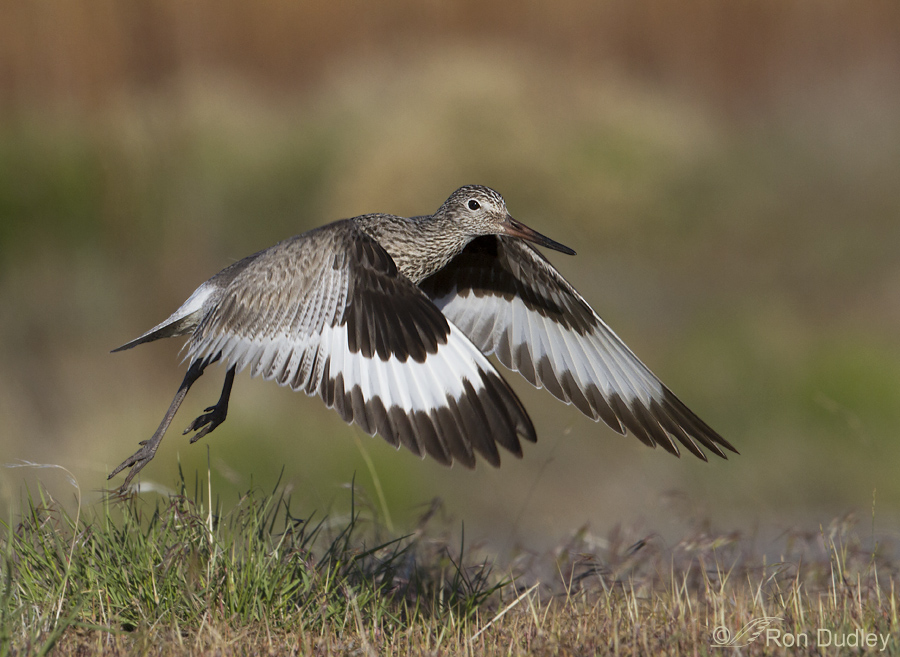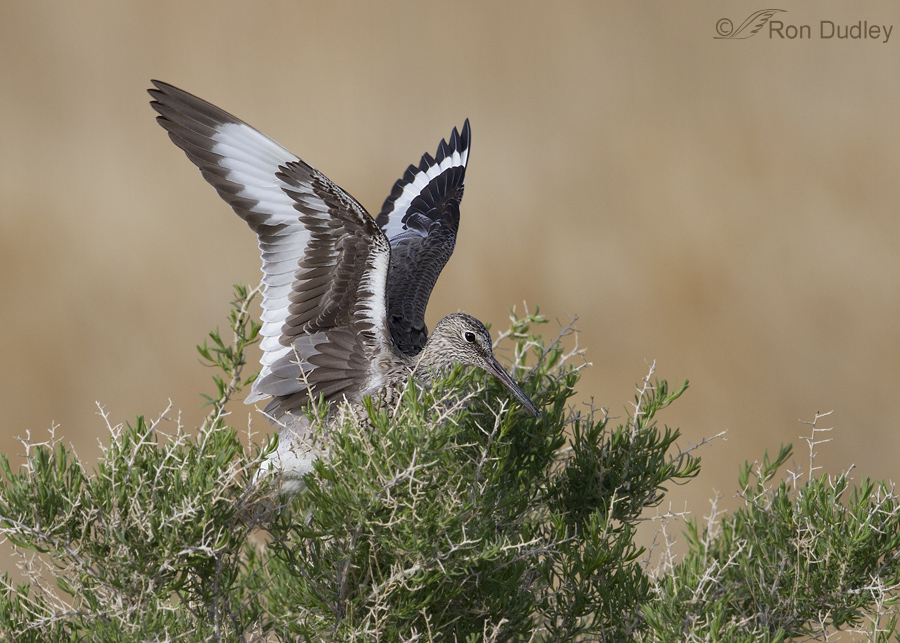Tag: willet
A Couple Of Willet Takeoffs
Willet – Allowing Enough Room For Wings At Take-off
Many things can go wrong when photographing birds at take-off and clipping wings is at or near the top of the list. The amount of room the photographer needs to allow for raised (or lowered) wings is hugely deceiving. Sure, you may catch the wings in a horizontal position without clipping them but that position is generally much less desirable.
Willet – A Flashy Transformation
Wispy Willet (and the effects of bokeh on an image)
A Willet, An Impaled Pellet And A Photographer Caught By Surprise
Willet – The Transformation Of An Avian Chameleon
A Clumsy Willet
Willet Take-off
Yesterday morning I found this Willet perched on one of the Tintic Quartzite boulders so common on the northern part of Antelope Island. The Willets are still active on the higher slopes of the island but it won’t be long until they’re spending most of their time along the shoreline and causeway.
Willets On Antelope Island
Juvenile Willets In Montana’s Centennial Valley
On my mid-July trip to the Centennial Valley I spent several days with an adult Willet and two juveniles. I reliably found them foraging for insects where a dirt road met Lower Red Rock Lake. Most of the shore birds and wading birds in this area are truly wild and difficult to approach but these three birds were the exception as they repeatedly let me get close as they fed and preened. 1/2500, f/7.1, ISO 400, 500 f/4 This was the most perfectly coiffed of the two juveniles, as the other youngster had a patch of unruly feathers on the back of its head and upper neck. 1/2500, f/7.1, ISO 500, 500 f/4 This particular site provided a bountiful Arthropod smorgasbord for the willets, both in the water and on the shoreline. The birds would feed on aquatic insects and crustaceans in the shallow water for a while and then get a little variety in their diet by coming up onto the shore and gobbling down hordes of terrestrial insects. Here, the more unkempt juvie (notice the fluff of feathers on the back of the head) feeds on a variety of dipterans that it flushes from the vegetation. I’ve cropped this image unconventionally to show more of the “bugs” in the air. I didn’t get a catch light in this shot but this image showed the insects best. 1/2000, f/7.1, ISO 400, 500 f/4. 1.4 tc At times some of the insects almost seemed to dare the Willets to pluck them out of…
Bathing Willet Adult
Several weeks ago I found this adult Willet near the shore of a lake in Beaverhead County in sw Montana. Most of the shorebirds in this remote area of the state aren’t used to people so they’re difficult to approach but this single adult (and a couple of juveniles – likely the offspring of this bird) were very cooperative – which makes me speculate that this adult had migrated from an area where it had become accustomed to humans. 1/2000, f/7.1, ISO 400, 500 f/4 It spent quite a while feeding on aquatic insects and crustaceans. 1/2500, f/7.1, ISO 400, 500 f/4 There was a variable breeze blowing and in many of these shots and I liked the effect it had on the water surface. 1/2000, f/7.1, ISO 400, 500 f/4 Then the Willet began to bathe… 1/2000, f/7.1, ISO 400, 500 f/4 and occasionally would even give me direct eye contact. 1/2000, f/7.1, ISO 400, 500 f/4 As it completed its bath it did a few wing flaps to get rid of some of the water. 1/2500, f/7.1, ISO 400, 500 f/4 And then a vigorous shake to help dry and rearrange the feathers. 1/2500, f/7.1, ISO 400, 500 f/4 Then of course there was the post-bath preening. 1/2000, f/7.1, ISO 400, 500 f/4 And finally a nice wing stretch to complete the bathing ritual. The wing movement scared up some flying insects from the foreground vegetation. Willets appear to be pretty much “plain brown birds” until they…
Sagebrush Perches
For me there’s just something wonderful about sagebrush. In fact, lots of things. When sagebrush is wet its smell is almost intoxicating (at least it is for me). When walking through it that scent comes wafting up and my mind can’t help but wander through old memories and cowboy songs. I love the silvery-gray-green color it lends to a hillside. The presence of sagebrush is essential for many species for nesting, habitat, protection or food. Sage Sparrows, Sage Thrashers and Loggerhead Shrikes nest within the plant and larks, Burrowing Owls and Long-billed Curlews nest on the ground in stands of sagebrush. Sagebrush dominates the diet of the Sage Grouse during late fall, winter and early spring. It also makes for an interesting perch for bird photography even though its growth patterns often put obstructions in front of the bird. Since sage is the dominant plant of the Great Basin in many areas I have regular opportunities to photograph birds perched on it. The various species (Big Sage and Black Sage for example) provide variety in color and leaf shape and sometimes you catch the bird on bare twigs or branches or layers of snow/ice on top of the plant. 1/1000, f/8, ISO 500, 500 f/4, 1.4 tc I photographed this Lark Sparrow on sage yesterday – as you can see, the leaf colors are a soft silvery green in early spring. 1/2000, f/8, ISO 500, 500 f/4, 1.4 tc And this Loggerhead Shrike is from this morning, with the Great Salt Lake (not sky) in the background. I thought I’d…
A Mixed Bag Of Recent Birds
These images were all taken over the last eight days, either at Bear River Migratory Bird Refuge or Antelope Island. Another one of my “potpourri” posts with no common theme except “feathers”. 1/640, f/7.1, ISO 640, 500 f/4 The Willets have finally come up on the island for their mating activities (as opposed to the shoreline for recuperation after migration) and I like to try to catch them perched high on the sagebrush where they call loudly to other Willets. 1/2500, f/6.3, ISO 500, 500 f/4, 1.4 tc Western Meadowlarks are in their glory right now and their distinctive songs reverberate all over the island. 1/5000, f/6.3, ISO 500, 500 f/4, 1.4 tc I got closer to this one than I usually can. 1/1600, f/7.1, ISO 500, 500 f/4 This Loggerhead Shrike was grooming peacefully when I noticed a distinct change in its behavior. 1/1250, f/7.1, ISO 500, 500 f/4 A Common Raven flew low overhead and this was the shrike’s reaction. It flattened its body out almost into a bullet shape and pointed that bullet at the raven as it passed. I’m guessing it was an instinctive behavior to present the smallest profile possible to a larger bird that might be a potential threat. It was comical to watch it turn as the raven flew by to keep its body pointed in the larger birds direction. 1/2000, f/6.3, ISO 500, 500 f/4, 1.4 tc I’m always happy to catch a Chukar perched on a boulder, especially when it isn’t one of the…
The Timelessness of a Buffalo Chip Perch
The American Bison is a relative newcomer to North America, having migrated from Eurasia over the Bering Straight about 10,000 years ago. As is common knowledge they once roamed in massive herds across most of the continent until commercial hunting and slaughter reduced their numbers to a few hundred by the end of the 19th century. 1/500, f/6.3, ISO 500, 500 f/4, 1.4 tc Today a herd of approximately 500 animals roams free on Antelope Island and that many large animals produce a lot of poop – commonly referred to as “buffalo chips”. Those chips are all over the island – like small dark islands in a sea of prairie grasses and tiny flowers and they’re tempting perches for a variety of bird species like Horned Larks and Meadowlarks. But this past week I was able to catch some larger birds using them as perches. 1/2000, f/6.3, ISO 500, 500 f/4, 1.4 tc In the spring some of the shorebirds and wading birds come up from the shore of the Great Salt Lake to higher ground on the island for their breeding activities – Long-billed Curlews among them. It seems that the added height of only a couple of inches provided by the chip is enough to significantly improve their view of the landscape for potential predators and also to help them keep an eye on other curlews in the area – there’s a lot of fighting and mating activities going on this time of year. To some viewers such a perch may have no aesthetic draw but I’m…
A Couple Of Willet Takeoffs
Willet – Allowing Enough Room For Wings At Take-off
Many things can go wrong when photographing birds at take-off and clipping wings is at or near the top of the list. The amount of room the photographer needs to allow for raised (or lowered) wings is hugely deceiving. Sure, you may catch the wings in a horizontal position without clipping them but that position is generally much less desirable.
Willet – A Flashy Transformation
Wispy Willet (and the effects of bokeh on an image)
A Willet, An Impaled Pellet And A Photographer Caught By Surprise
Willet – The Transformation Of An Avian Chameleon
A Clumsy Willet
Willet Take-off
Yesterday morning I found this Willet perched on one of the Tintic Quartzite boulders so common on the northern part of Antelope Island. The Willets are still active on the higher slopes of the island but it won’t be long until they’re spending most of their time along the shoreline and causeway.
Willets On Antelope Island
Juvenile Willets In Montana’s Centennial Valley
On my mid-July trip to the Centennial Valley I spent several days with an adult Willet and two juveniles. I reliably found them foraging for insects where a dirt road met Lower Red Rock Lake. Most of the shore birds and wading birds in this area are truly wild and difficult to approach but these three birds were the exception as they repeatedly let me get close as they fed and preened. 1/2500, f/7.1, ISO 400, 500 f/4 This was the most perfectly coiffed of the two juveniles, as the other youngster had a patch of unruly feathers on the back of its head and upper neck. 1/2500, f/7.1, ISO 500, 500 f/4 This particular site provided a bountiful Arthropod smorgasbord for the willets, both in the water and on the shoreline. The birds would feed on aquatic insects and crustaceans in the shallow water for a while and then get a little variety in their diet by coming up onto the shore and gobbling down hordes of terrestrial insects. Here, the more unkempt juvie (notice the fluff of feathers on the back of the head) feeds on a variety of dipterans that it flushes from the vegetation. I’ve cropped this image unconventionally to show more of the “bugs” in the air. I didn’t get a catch light in this shot but this image showed the insects best. 1/2000, f/7.1, ISO 400, 500 f/4. 1.4 tc At times some of the insects almost seemed to dare the Willets to pluck them out of…
Bathing Willet Adult
Several weeks ago I found this adult Willet near the shore of a lake in Beaverhead County in sw Montana. Most of the shorebirds in this remote area of the state aren’t used to people so they’re difficult to approach but this single adult (and a couple of juveniles – likely the offspring of this bird) were very cooperative – which makes me speculate that this adult had migrated from an area where it had become accustomed to humans. 1/2000, f/7.1, ISO 400, 500 f/4 It spent quite a while feeding on aquatic insects and crustaceans. 1/2500, f/7.1, ISO 400, 500 f/4 There was a variable breeze blowing and in many of these shots and I liked the effect it had on the water surface. 1/2000, f/7.1, ISO 400, 500 f/4 Then the Willet began to bathe… 1/2000, f/7.1, ISO 400, 500 f/4 and occasionally would even give me direct eye contact. 1/2000, f/7.1, ISO 400, 500 f/4 As it completed its bath it did a few wing flaps to get rid of some of the water. 1/2500, f/7.1, ISO 400, 500 f/4 And then a vigorous shake to help dry and rearrange the feathers. 1/2500, f/7.1, ISO 400, 500 f/4 Then of course there was the post-bath preening. 1/2000, f/7.1, ISO 400, 500 f/4 And finally a nice wing stretch to complete the bathing ritual. The wing movement scared up some flying insects from the foreground vegetation. Willets appear to be pretty much “plain brown birds” until they…
Sagebrush Perches
For me there’s just something wonderful about sagebrush. In fact, lots of things. When sagebrush is wet its smell is almost intoxicating (at least it is for me). When walking through it that scent comes wafting up and my mind can’t help but wander through old memories and cowboy songs. I love the silvery-gray-green color it lends to a hillside. The presence of sagebrush is essential for many species for nesting, habitat, protection or food. Sage Sparrows, Sage Thrashers and Loggerhead Shrikes nest within the plant and larks, Burrowing Owls and Long-billed Curlews nest on the ground in stands of sagebrush. Sagebrush dominates the diet of the Sage Grouse during late fall, winter and early spring. It also makes for an interesting perch for bird photography even though its growth patterns often put obstructions in front of the bird. Since sage is the dominant plant of the Great Basin in many areas I have regular opportunities to photograph birds perched on it. The various species (Big Sage and Black Sage for example) provide variety in color and leaf shape and sometimes you catch the bird on bare twigs or branches or layers of snow/ice on top of the plant. 1/1000, f/8, ISO 500, 500 f/4, 1.4 tc I photographed this Lark Sparrow on sage yesterday – as you can see, the leaf colors are a soft silvery green in early spring. 1/2000, f/8, ISO 500, 500 f/4, 1.4 tc And this Loggerhead Shrike is from this morning, with the Great Salt Lake (not sky) in the background. I thought I’d…
A Mixed Bag Of Recent Birds
These images were all taken over the last eight days, either at Bear River Migratory Bird Refuge or Antelope Island. Another one of my “potpourri” posts with no common theme except “feathers”. 1/640, f/7.1, ISO 640, 500 f/4 The Willets have finally come up on the island for their mating activities (as opposed to the shoreline for recuperation after migration) and I like to try to catch them perched high on the sagebrush where they call loudly to other Willets. 1/2500, f/6.3, ISO 500, 500 f/4, 1.4 tc Western Meadowlarks are in their glory right now and their distinctive songs reverberate all over the island. 1/5000, f/6.3, ISO 500, 500 f/4, 1.4 tc I got closer to this one than I usually can. 1/1600, f/7.1, ISO 500, 500 f/4 This Loggerhead Shrike was grooming peacefully when I noticed a distinct change in its behavior. 1/1250, f/7.1, ISO 500, 500 f/4 A Common Raven flew low overhead and this was the shrike’s reaction. It flattened its body out almost into a bullet shape and pointed that bullet at the raven as it passed. I’m guessing it was an instinctive behavior to present the smallest profile possible to a larger bird that might be a potential threat. It was comical to watch it turn as the raven flew by to keep its body pointed in the larger birds direction. 1/2000, f/6.3, ISO 500, 500 f/4, 1.4 tc I’m always happy to catch a Chukar perched on a boulder, especially when it isn’t one of the…
The Timelessness of a Buffalo Chip Perch
The American Bison is a relative newcomer to North America, having migrated from Eurasia over the Bering Straight about 10,000 years ago. As is common knowledge they once roamed in massive herds across most of the continent until commercial hunting and slaughter reduced their numbers to a few hundred by the end of the 19th century. 1/500, f/6.3, ISO 500, 500 f/4, 1.4 tc Today a herd of approximately 500 animals roams free on Antelope Island and that many large animals produce a lot of poop – commonly referred to as “buffalo chips”. Those chips are all over the island – like small dark islands in a sea of prairie grasses and tiny flowers and they’re tempting perches for a variety of bird species like Horned Larks and Meadowlarks. But this past week I was able to catch some larger birds using them as perches. 1/2000, f/6.3, ISO 500, 500 f/4, 1.4 tc In the spring some of the shorebirds and wading birds come up from the shore of the Great Salt Lake to higher ground on the island for their breeding activities – Long-billed Curlews among them. It seems that the added height of only a couple of inches provided by the chip is enough to significantly improve their view of the landscape for potential predators and also to help them keep an eye on other curlews in the area – there’s a lot of fighting and mating activities going on this time of year. To some viewers such a perch may have no aesthetic draw but I’m…


